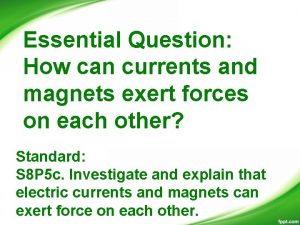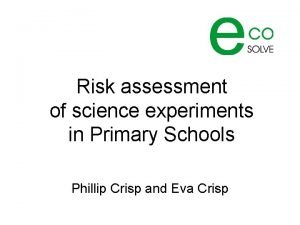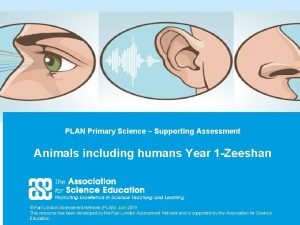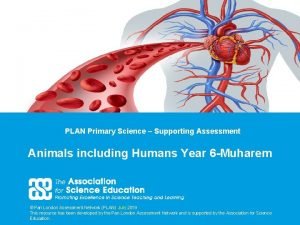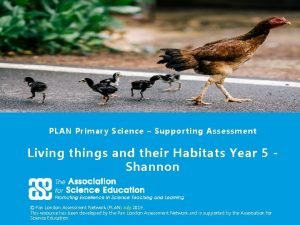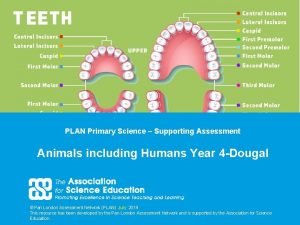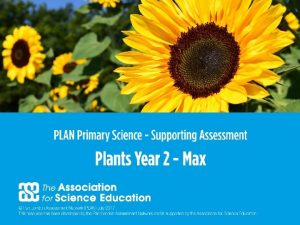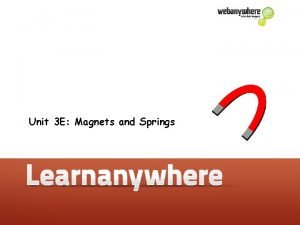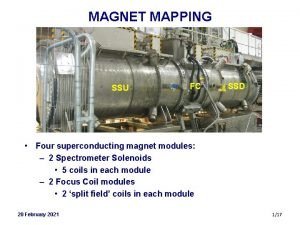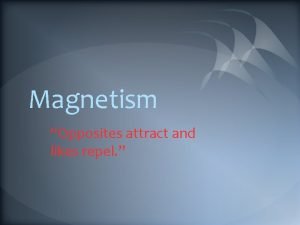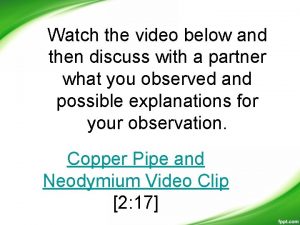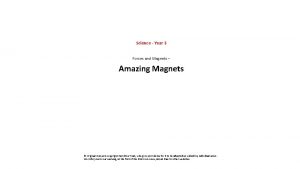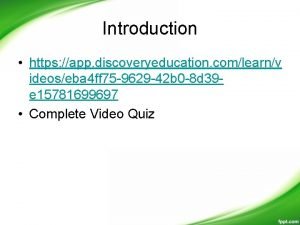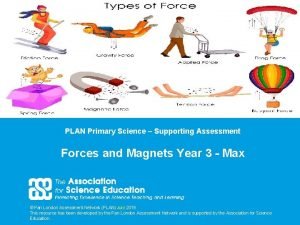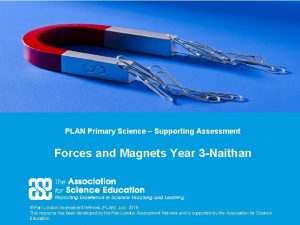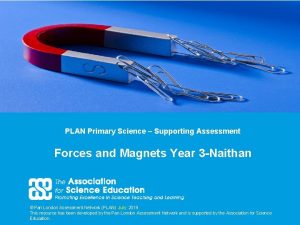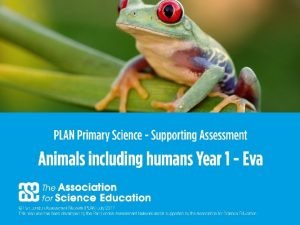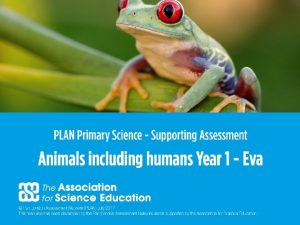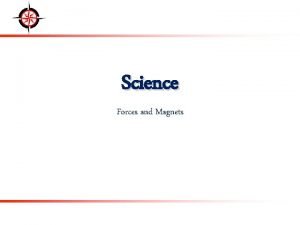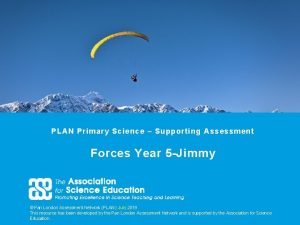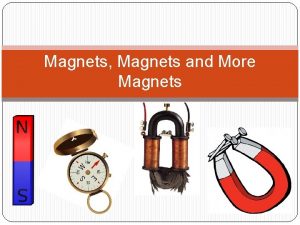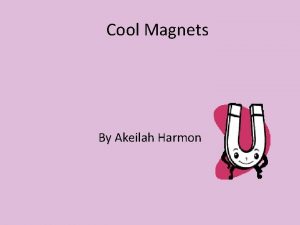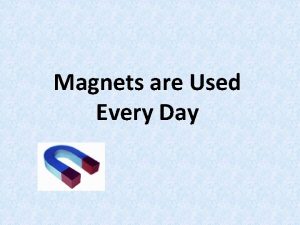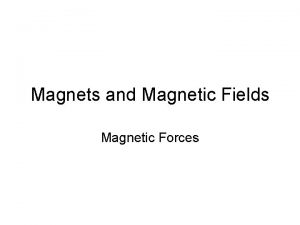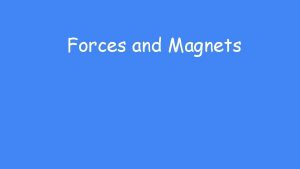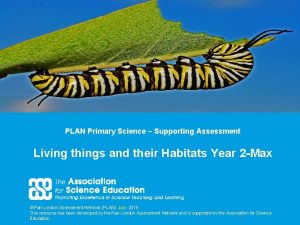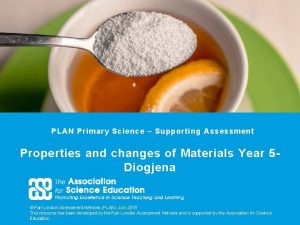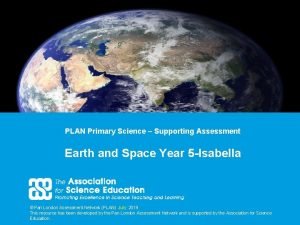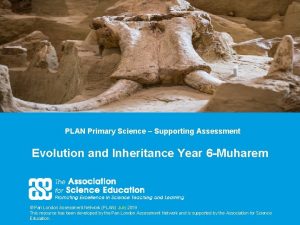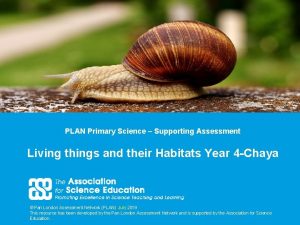PLAN Primary Science Supporting Assessment Forces and Magnets


























- Slides: 26

PLAN Primary Science – Supporting Assessment Forces and Magnets Year 3 -Naithan © Pan London Assessment Network (PLAN) July 2019 This resource has been developed by the Pan London Assessment Network and is supported by the Association for Science Education. 1

PLAN Primary Science - Supporting Assessment PLAN Primary Science is a set of resources produced to enable teachers to have a clearer understanding of National Curriculum expectations for meeting the standard. Annotated collections of children’s work provide examples of what working at the expected standard for primary science might look like for the knowledge and conceptual understanding statements of the programmes of study (POS). It is not the intention of these resources to specifically exemplify the working scientifically statements. However, aspects of working scientifically have been shown as an integral part of the teaching and learning of the knowledge and concepts. The resources provided have been cross moderated multiple times before publishing so that they can be used with confidence by teachers and subject leaders. Each collection of work shows one example of how a pupil has met National Curriculum statements for a particular area of content but these are not intended to be the definitive way of teaching these statements. 2

Structure of the resources Each resource contains the relevant National Curriculum statements for the unit of work and prior learning, a planning matrix, annotated work and a summary sheet. The matrix provides an interpretation of the key learning of the National Curriculum statements, and suggestions of key vocabulary. In order to be meet the expectations pupils must firstly understand the key concept and then be provided with opportunities to apply that knowledge. This is a key planning tool. Key Learning Secure Possible Evidence Show understanding Overview paragraph describing of a concept by curriculum using scientific vocabulary correctly Key vocabulary – list of words Possible ways to demonstrate key learning, particularly correct usage of vocabulary Apply knowledge in familiar related contexts across a range of enquiry types Possible ways to demonstrate that a pupil has gone beyond recall of facts and can apply the key learning, for example using the vocabulary and basic principles to produce explanations, usually within Working Scientifically contexts. Suggestions of contexts to use. 3

Contents of the materials Please note: The NC statements for each topic area for the relevant year group are stated on the slide. Only the statements in bold on that slide have been exemplified. In these cases the teachers have chosen to split the statements within the topic area to teach at different times. The prior NC statements relevant to the topic area are also stated and use to determine pupils’ knowledge at the start of the unit. Each slide has been annotated with coloured text. Please see key below: Red statements Commentary to explain how evidence meets/does not meet NC Blue Commentary to highlight features of working scientifically Green Pupil Speak Grey Other relevant information eg. vocabulary used 4

Year 2 Statement – Prior learning 2 statements Pupils should be taught to: • find out how the shapes of solid objects made from some materials can be changed by squashing, bending, twisting and stretching (2 -Everyday materials) 5

Year 33 statements Statements Year Pupils should be taught to: • compare how things move on different surfaces (3 -Forces) • notice that some forces need contact between two objects, but magnetic forces can act at a distance (3 -Forces) • observe how magnets attract or repel each other and attract some materials and not others (3 -Forces) • compare and group together a variety of everyday materials on the basis of whether they are attracted to a magnet, and identify some magnetic materials (3 -Forces) • describe magnets as having two poles (3 -Forces) • predict whether two magnets will attract or repel each other, depending on which poles are facing (3 -Forces) 6

Later Statements Pupils do not need to be taught content they will learn in later year groups. They can be challenged by applying the content for their year group in broader contexts. In Year 5 pupils will be taught to: • explain that unsupported objects fall towards the Earth because of the force of gravity acting between the Earth and the falling object (5 -Forces) • identify the effects of air resistance, water resistance and friction, that act between moving surfaces (5 -Forces) • recognise that some mechanisms, including levers, pulleys and gears, allow a smaller force to have a greater effect. (5 Forces) In Key Stage 3 pupils will be taught about: magnetic fields by plotting with compass, representation by field lines Earth’s magnetism, compass and navigation.

Key learning Possible Evidence Shows understanding of a concept using scientific vocabulary correctly A force is a push or a pull. When an object moves on a surface, the texture of the surface and the object affect how it moves. It may help the object to move better or it may hinder its movement e. g. ice skater compared to walking on ice in normal shoes. A magnet attracts magnetic material. Iron and nickel and other materials containing these e. g. stainless steel, are magnetic. The strongest parts of a magnet are the poles. Magnets have two poles – a north pole and a south pole. If two like poles e. g. two north poles, are brought together they will push away from each other – repel. If two unlike poles e. g. a north and south, are brought together they will pull together – attract. For some forces to act there must be contact e. g. a hand opening a door, the wind pushing the trees. Some forces can act at a distance e. g. magnetism. The magnet does not need to touch the object that it attracts. Key vocabulary: Force, push, pull, twist, contact force, non-contact force, magnetic force, magnet, strength, bar magnet, ring magnet, button magnet, horseshoe magnet, attract, repel, magnetic material, metal, iron, steel, poles, north pole, south pole Can give examples of forces in everyday life Can give examples of objects moving differently on different surfaces Can name a range of types of magnets and show the poles attract and repel Can draw diagrams using arrows to show the attraction and repulsion between the poles of magnets Applying knowledge in familiar related contexts, including a range of enquiries Carry out investigations to explore how objects move on different surfaces e. g. spinning tops/coins, rolling balls/cars, clockwork toys, soles of shoes etc. Explore what materials are attracted to a magnet Classify materials according to whether they are magnetic Explore the way that magnets behave in relation to each other Use a marked magnet to find the unmarked poles on other types of magnets Explore how magnets work at a distance e. g. through the table, in water, jumping paper clip up off the table Devise an investigation to test the strength of magnets Can use their results to describe how objects move on different surfaces Can use their results to make predictions for further tests e. g. it will spin for longer on this surface than that, but not as long as it spun on that surface Can use classification evidence to identify that some metals but not all are magnetic Through their exploration they can show like poles repel and unlike poles attract and name unmarked poles Can use test data to rank magnets SECURE Assessment guidance

Initial assessment activity – carousel of activities • find out how the shapes of solid objects made from some materials can be changed by squashing, bending, twisting and stretching The children completed a carousel of activities where they explored a range of toys/games that involved forces to move them. The fish stick to the magnet. As you twist the knobs it tilts and the ball moves. When one shape turns it moves the others next to it. It moved in lots of different ways. I made my name by rolling it into sausages and then bending them to make the letters. I could move the ball without touching it. Naithan is aware that you can make things move or change their shape. 9

Elicitation activity – creating a mind map The children were then asked to complete a mind map to show what they already knew about forces and magnets and to generate some questions. Sticky is used rather than attract The mind map shows limited knowledge about forces and magnets. Does not name any types of magnets Does not name any magnetic materials 10

Identifying pushes and pulls The teacher showed them the activities they had carried out in the carousel activity and asked them how they made things move. The children started to use the words push and pull. She demonstrated a push and pull and asked children to move around the classroom and find things that they could move by pushing, pulling or both. She also asked them to find some things that they could not move by pushing or pulling. She then asked them to record this in a way of their choosing. Naithan chose to record using an intersecting Venn diagram. Other children used a table or simply labelled each individual object. 11

Cars on different surfaces • compare how things move on different surfaces The children were given a ramp and four surfaces. A range of measuring equipment was left out for them to choose from. They were also given a table to record their results which prompted them to try each surface three times The car went best on A which was the wood. Naithan chose the tape measure for his group to use and took the measurements and recorded them correctly in the table including the units used. When talking about his results he only considers the surface that was the best. He does not compare the surfaces. 12

Cars on different surfaces (contd. ) • compare how things move on different surfaces The children then presented their results in a bar chart and the teacher asked them to talk to each other about the graph. The car went 29 cm on the wood. This was the furthest. It only went 9 cm on the wool. It actually went about the same distance on the sandpaper and foam. Teacher: Why do you think it went different distances on the surfaces? The wool was fluffy and slowed the car down. The wood was smooth and didn’t slow it down. The sandpaper and foam feel quite similar Naithan correctly drew the axes and the bars on his graph. Naithan is now showing an awareness that it is the texture of the surface that affects the movement. 13

Spinning tops on different surfaces • compare how things move on different surfaces The children were given a spinning top and asked to see how it moved on different surfaces It didn’t spin on the doormat at all as the wings got caught. It span really well on the smooth table. I don’t think it will spin for as long on the sugar paper as it is a bit rougher than the table. Naithan is able to make further predictions based on what he has observed. Naithan uses his previous learning that the texture of the surface affects the movement over it, to make predictions during this exploration. 14

Exploring magnets • observe how magnets attract or repel each other and attract some materials and not others • compare and group together a variety of everyday materials on the basis of whether they are attracted to a magnet, and identify some magnetic materials • describe magnets as having two poles • predict whether two magnets will attract or repel each other, depending on which poles are facing The children were given some magnets and other resources in a box to explore. I can make the paper clip on the table move by using this magnet under the table. This one doesn’t work though. Sometimes two magnets push away and sometimes they stick together. Through the exploration Naithan discovers that the magnet does not need to be in contact with the paper clip to make it move. This needs reinforcing. He also notices the attraction and repulsion between magnets but does not use the correct scientific 15 vocabulary or talk about the poles.

Explaining their learning verbally • observe how magnets attract or repel each other and attract some materials and not others • compare and group together a variety of everyday materials on the basis of whether they are attracted to a magnet, and identify some magnetic materials • describe magnets as having two poles • predict whether two magnets will attract or repel each other, depending on which poles are facing The teacher showed an animation of the poles of two magnets attracting and repelling each other and highlighted this new key vocabulary. The children then practiced verbally explaining what they had learnt to a partner and then consolidated it in writing and drawings. Naithan confidently demonstrates the like poles repelling and unlike poles attracting using all the correct scientific vocabulary, in this video. 16

What makes it move? • notice that some forces need contact between two objects, but magnetic forces can act at a distance The children were asked to think about a range of things that move and whether these were contact or non-contact forces. These show objects being mostly being moved by air Understandably Naithan cannot identify the force that makes an aeroplane move These show a direct push or pull by a person Naithan has not realised at this stage that things that are moved by air are still being moved by a contact force (the air is in contact with the 17 object)

What makes it move? (contd. ) • notice that some forces need contact between two objects, but magnetic forces can act at a distance Tor address this misconception the children carried out a carousel of activities that involved making things move in different ways, which included directly pushing or pulling, using air and using magnets; moving a paper clip around a maze using a magnet, using a fan to blow a ping pong ball into a hole, playing mini snooker using a small ball and pencil as the cue and exploring balloon rockets. The children were asked to think what was making each object move and to think about whether that involved contact between the two objects or not. When we played snooker the pencil was touching the ball so they are in contact. The fan blows air at the ball which is touching the ball. Only the magnet can work without actually touching the paper clip. Naithan understands that most forces need contact whereas magnetic forces do not need contact and can act at a distance. 18

Exploring magnets • observe how magnets attract or repel each other and attract some materials and not others • compare and group together a variety of everyday materials on the basis of whether they are attracted to a magnet, and identify some magnetic materials As a starter activity the teacher buried a range of small objects in a tray of sand. The children took turns to use a magnet to pull out an object. The children noticed that all the objects were made at least partly of metal and this ‘stuck’ to the magnet. The teacher introduced the word attract. There may still be some objects buried that are not made of metal, like a plastic bottle top. That wouldn’t be attracted to the magnet. Naithan is aware that some materials are magnetic and others, like plastic, are not. He is using the word attract now. He is not showing awareness that not all metals are magnetic. 19

Classifying coins • observe how magnets attract or repel each other and attract some materials and not others • compare and group together a variety of everyday materials on the basis of whether they are attracted to a magnet, and identify some magnetic materials The children were given a selection of coins and asked to sort them in different ways. Naithan suggested sorting by shape, colour, ridges on the edge, dirtiness. The children were then asked to sort according to whether they thought they were magnetic or not. I think all the coins will be magnetic as they are made of metal. This is a common misconception that all metals are magnetic They were then given a magnet to test their ideas. Not all the coins were magnetic even though they were made of metal. Some silver coins were magnetic and some were not. They must be made of different types of metal. Naithan is aware that some metals are magnetic and that others are not. 20

Testing the strength of magnets • observe how magnets attract or repel each other and attract some materials and not others • compare and group together a variety of everyday materials on the basis of whether they are attracted to a magnet, and identify some magnetic materials As an enrichment activity whilst the teacher worked with another group of children to consolidate the key vocabulary, the children were asked to carry out a test into the strength of 4 magnets. Naithan followed the instructions to carry out the test, recorded his results in the table and correctly used his data to identify the strongest and weakest magnets. 21

Testing the strength of magnets (contd. ) • observe how magnets attract or repel each other and attract some materials and not others • compare and group together a variety of everyday materials on the basis of whether they are attracted to a magnet, and identify some magnetic materials The next lessons the children were asked to discuss the three statements presented in the style of a concept cartoon. The bar magnet is the strongest The biggest magnet is the strongest You cannot tell which is the strongest magnet by looking at them Last week my bar magnet was not as strong as the wand magnet. Naithan used his evidence from the previous activity to refute the first statement about the bar magnet. You can’t tell until you test them as sometimes a big magnet can be weak and a small one strong. The children were given a selection of magnets and asked to quickly test to find the strongest magnet. Naithan used the same method as the previous test but as he did not have the paper scale he used a ruler to measure the distance. 22

Testing the paper clip on different surfaces • compare how things move on different surfaces • observe how magnets attract or repel each other and attract some materials and not others • compare and group together a variety of everyday materials on the basis of whether they are attracted to a magnet, and identify some magnetic materials The children were then asked to use their strongest magnet and test how the surface affected the distance the paper clip need to slide towards the magnet. . Naithan makes a prediction based on previous observations. Naithan has consistently demonstrated that he understands that the texture of the surface affects how an object moves on it. 23

Testing the paper clip on different surfaces • compare how things move on different surfaces • observe how magnets attract or repel each other and attract some materials and not others • compare and group together a variety of everyday materials on the basis of whether they are attracted to a magnet, and identify some magnetic materials The children were then asked to write about what they had learnt from the investigation. Key vocabulary – attracted, used here unprompted The teacher asked Naithan to look again at his evidence to check this statement. The paper clip was Naithan combines his attracted from Teacher: Where is the friction? knowledge of magnets and further from the movement of different surfaces Naithan: Oh it is on the paper magnet not closer. clip not the magnet as it is the showing he has a good 24 understanding of both concepts. paper clip that moves.

Overall Summary Naithan has explored how objects move on different surfaces using cars, spinning tops and paper clips attracted by a magnet. He can make predictions about how well an object will move based on the texture of the surface. He has explored making objects move using contact forces and those that act at a distance (magnetic forces). He can talk about the poles of magnets and how these can attract or repel according to their orientation. He knows that some materials are magnetic and that others, such as plastic, are not. Through sorting coins he learnt that not all metals are magnetic. 25

Acknowledgements 26
 How do currents and magnets exert forces on each other
How do currents and magnets exert forces on each other Science risk assessment primary school
Science risk assessment primary school Fixation omission emphasis
Fixation omission emphasis Fixation omission emphasis
Fixation omission emphasis Plan primary science
Plan primary science Plan primary science
Plan primary science Plan primary science
Plan primary science Digestive parts
Digestive parts Plan primary science
Plan primary science Like parallel forces examples
Like parallel forces examples Contact and non contact forces
Contact and non contact forces Balanced forces and unbalanced forces venn diagram
Balanced forces and unbalanced forces venn diagram What are constructive and destructive forces
What are constructive and destructive forces What is your favorite science subject
What is your favorite science subject Magnets and springs
Magnets and springs The properties and interactions of magnets
The properties and interactions of magnets Lesson outline lesson 1 magnets and magnetic fields
Lesson outline lesson 1 magnets and magnetic fields Scrap yard crane electromagnet diagram
Scrap yard crane electromagnet diagram Ssd and magnets
Ssd and magnets Opposites attract and likes repel
Opposites attract and likes repel Electromagnet in speakers
Electromagnet in speakers Magnets attract and repel
Magnets attract and repel Currents and magnets summarizer
Currents and magnets summarizer The forces shown above are pushing/pulling forces
The forces shown above are pushing/pulling forces Intermolecular forces vs intramolecular forces
Intermolecular forces vs intramolecular forces Intermolecular forces vs intramolecular forces
Intermolecular forces vs intramolecular forces Intramolecular forces vs intermolecular forces
Intramolecular forces vs intermolecular forces
